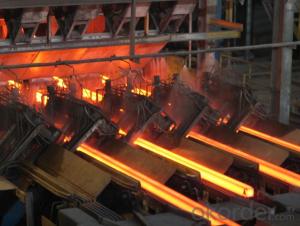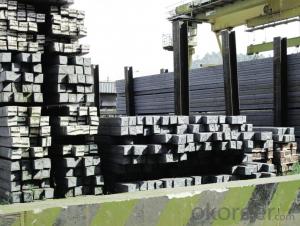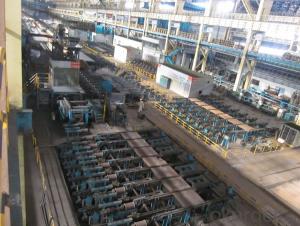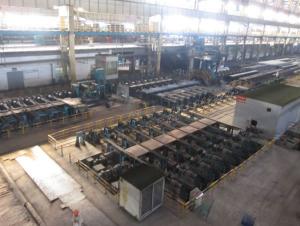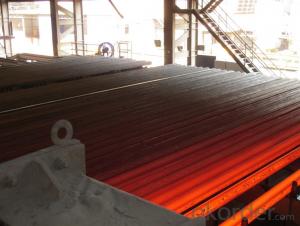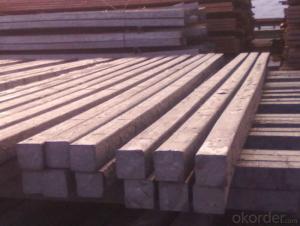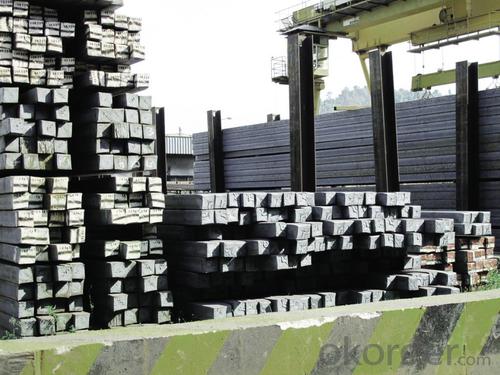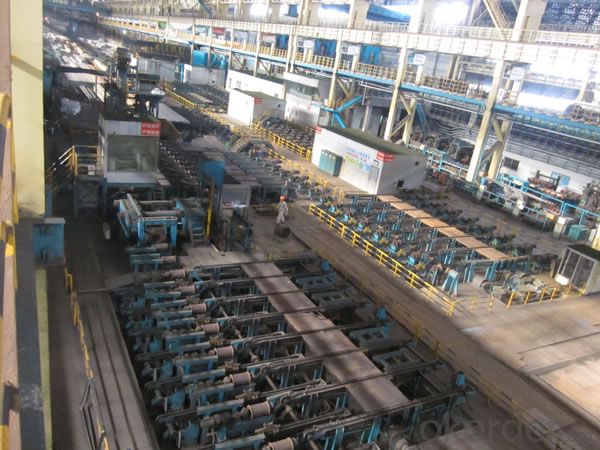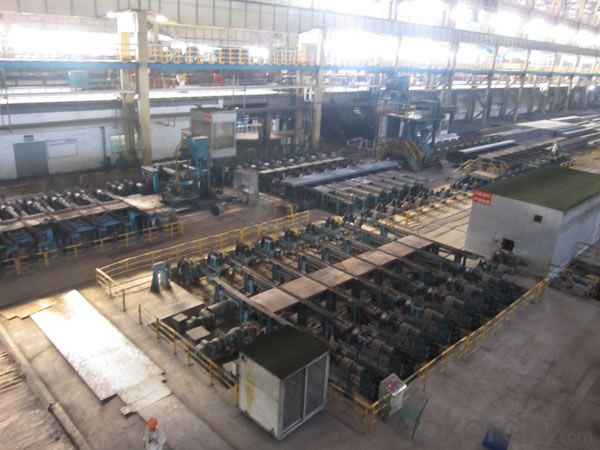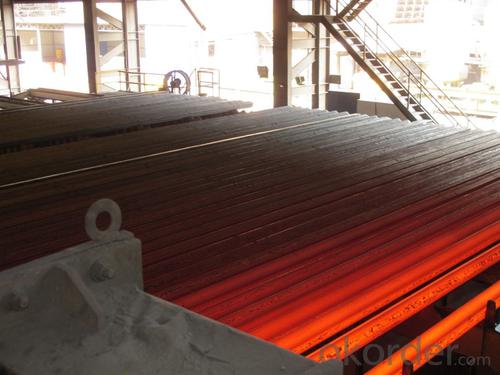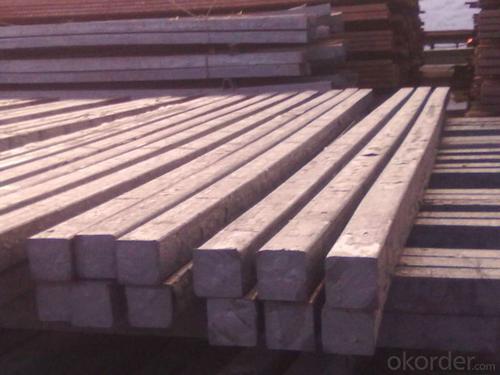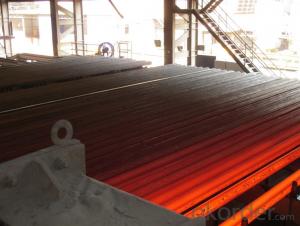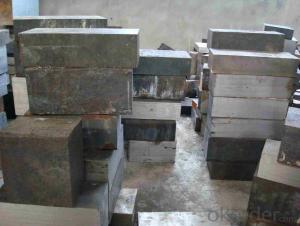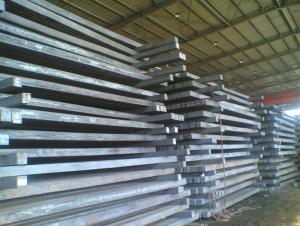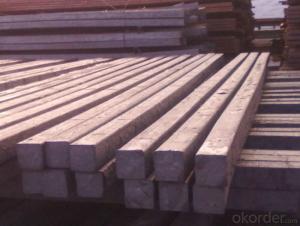Hot Rolled Square Steel Billet 3SP Standard 105mm
- Loading Port:
- Shanghai
- Payment Terms:
- TT OR LC
- Min Order Qty:
- 2000 m.t.
- Supply Capability:
- 10000 m.t./month
OKorder Service Pledge
OKorder Financial Service
You Might Also Like
Structure of Hot Rolled Square Steel Billet 3SP Standard 105mm
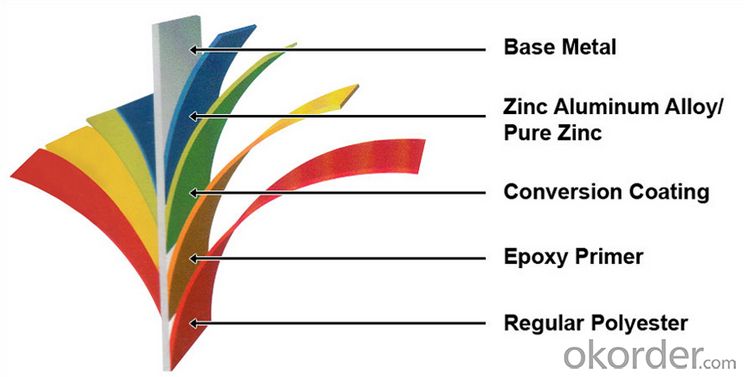
Description of Hot Rolled Square Steel Billet 3SP Standard 105mm
PPGI is made by cold rolled steel sheet and galvanized steel sheets as baseplate, through the surface pretreatment (degreasing, cleaning, chemical conversion processing), coated by the method of continuous coatings (roller coating method),
and after roasting and cooling. Zinc coating: Z60, Z80, Z100, Z120, Z180, Z275, G30, G60, G90
Alu-zinc coating: AZ60, AZ80, AZ100, AZ120, AZ180, G30, G60, G90
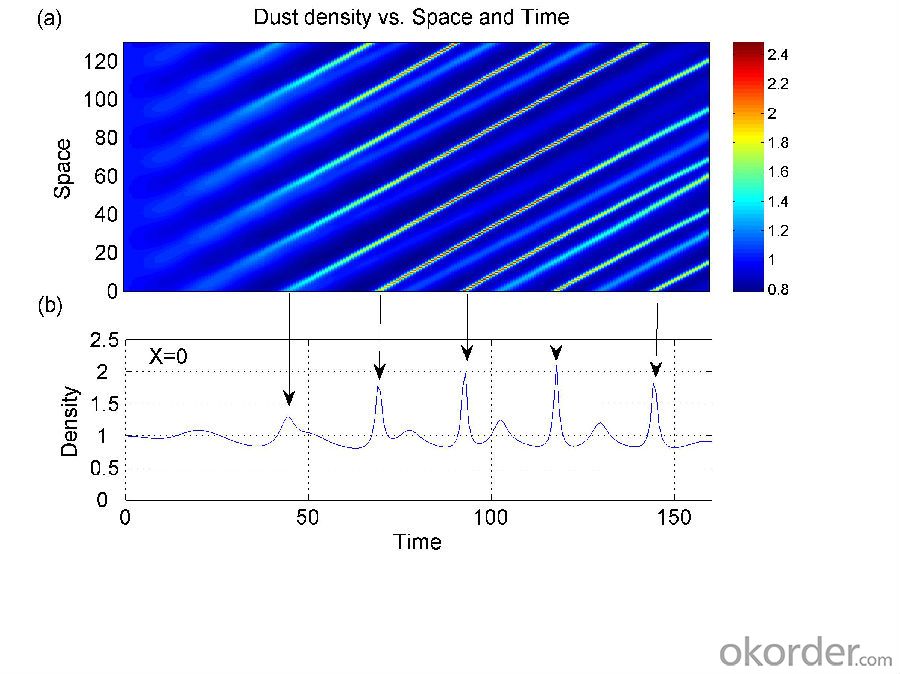
Main Feature of Hot Rolled Square Steel Billet 3SP Standard 105mm
1) Excellent corrosion resistance: The zinc layer provides a good protection of Pre-painted Galvanizeed Steel Sheet.
2) High heat resistance: The reflective surface of the material aids in efficiently reflecting the sunlight away and in turn reducing the amount of heat transmitted. The thermal reflectivity converts into energy savings.
3) Aesthetics: Pre-Painted Galvanized steel sheet is available in plethora of patterns and multiple sizes as per the requirements that given by our customers.
4) Versatility: can be used in the various areas.Standard seaworthy export packing: 3 layers of packing, inside is kraft paper, water plastic film is in the middle and outside GI steel sheet to be covered by steel strips with lock, with inner coil sleeve.
Applications of Hot Rolled Square Steel Billet 3SP Standard 105mm
1) Automotive bodies: filters, fuel tanks, etc.
2) Construction materials: roofings, welding pipes,
3) Electric and electronic appliances: computer cans, etc.
4) Steel cans: containers, etc.
5) Steel furniture: washing machines, refrigerators, microwaves, etc.
6) Drums
7) Office equipment: printer, recorders, etc.
8) Motors and transformers
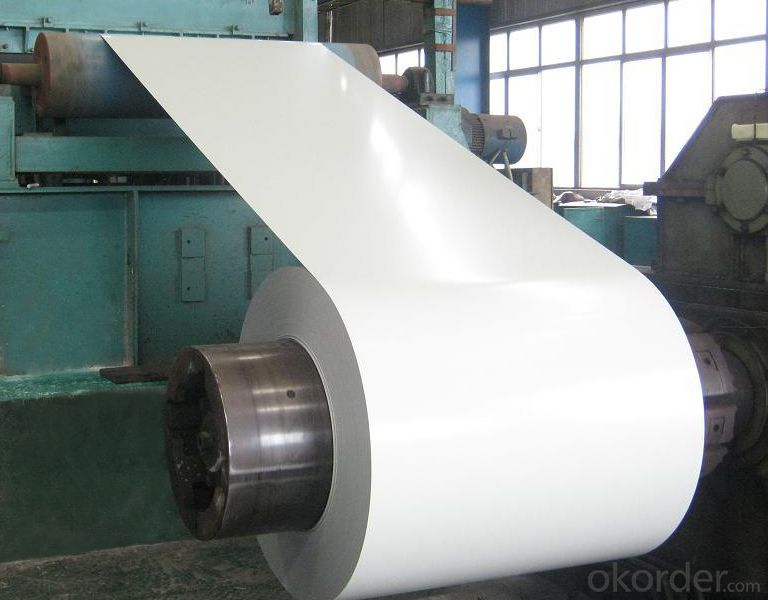
Specifications of Hot Rolled Square Steel Billet 3SP Standard 105mm
| Classified symbol | Yield Point Minimum N/mm2 | Tensile Strength Minimum | Elongation Minimum % | Application | ||||
| N/mm2 | Nominal Thickness mm (t) | |||||||
| JIS | Yogic | 0.25-0.4 | 0.4-0.6 | 0.6-1.0 | 1.0-1.6 | |||
| G3312 | specification | |||||||
| CGCC | CGCC | -205 | -270 | -20 | -21 | -24 | -24 | Commercial |
| CGCD | CGCD | --- | 270 | --- | 27 | 31 | 32 | Drawing |
| --- | CG340 | 245 | 340 | 20 | 20 | 20 | 20 | Structural |
| CGC400 | CG400 | 295 | 400 | 16 | 17 | 18 | 18 | Structural |
| CGC440 | CG440 | 335 | 440 | 14 | 15 | 16 | 18 | Structural |
| CGC490 | CG490 | 365 | 490 | 12 | 13 | 14 | 16 | Structural |
| CGC570 | CG570 | 560 | 570 | --- | --- | --- | --- | Structural |
| ASTM Designation | Yield Point Minimum | Tensile Strength Minimum | Elongation Minimum % | Application | Q/BQB 445-2004(China standard) | ASM A653/A653M | JISG 3312 | |
| ksi(MPa) | ksi(MPa) | TDC51D+Z | (CS TYPE A+Z) | CGCC | ||||
| A653(M)-99 CS TYPE A,B,C | --- | --- | --- | Commercial | TDC52D+Z | CGCD | ||
| A653(M)-99 FS | --- | --- | --- | Lock Forming | TS250GD+Z | (G250+Z) | - | |
| A653(M)-99 DS | --- | --- | --- | Drawing | TS300GS+Z | (G300+Z) | CGC 400 | |
| A653(M)-99 SS Grade33(230) | 33(230) | 45(310) | 20 | Structural | TS350GD+Z | (G350+Z) | CGC490 | |
| A653(M)-99 SS Grade37(255) | 37(255) | 52(360) | 18 | Structural | TS550GD+Z | (G550+Z) | CGC570 | |
| A653(M)-99 SS Grade40(275) | 40(275) | 55(380) | 16 | Structural | ||||
| A653(M)-99 SS Grade50(345) | 50(345) | 65(450) | 12 | Structural | ||||
| A653(M)-99 SS Grade80(550) | 80(550) | 82(570) | --- | Structural | ||||
FAQ of Hot Rolled Square Steel Billet 3SP Standard 105mm
We have organized several common questions for our clients,may help you sincerely:
1. How Can I Visit There?
Our company is located in Tianjin City, China, near Beijing. You can fly to Tianjin Airport Directly. All our clients, from home or aboard, are warmly welcome to visit us!
2. How Can I Get Some Sample?
We are honored to offer you sample.
3. Why choose CNBM?
1, ISO, BV, CE, SGS approved.
2, Competitive price and quality.
3, Efficient service team online for 24 hours.
4, Smooth production ability(50000tons/month) .
5, quick delivery and standard exporting package.
6, Flexible payment with T/T, L/C, Paypal, Kunlun bank, etc .
- Q: How are steel billets used in the manufacturing of railway equipment?
- Steel billets are an essential component in the manufacturing of railway equipment. These billets, which are semi-finished steel products, are typically used as raw material for various railway components such as rails, wheels, axles, and other structural parts. To begin the manufacturing process, the steel billets are subjected to heating within a furnace to reach the desired temperature for hot rolling. This heating process helps to improve the malleability and ductility of the steel, making it easier to shape and form into the desired railway equipment components. Once the steel billets have reached the appropriate temperature, they are then passed through a series of rolling mills. During this stage, the billets are subjected to intense pressure, causing them to elongate and change their shape. This process is known as hot rolling and is crucial for transforming the steel billets into long, slender sections such as rails or axles. After hot rolling, the railway components are further processed to achieve the desired shape and specifications. For example, rails may undergo a process called head hardening to enhance their wear resistance and strength. Similarly, wheels and axles may undergo additional heat treatment processes to improve their mechanical properties and durability. It is important to note that the quality of the steel billets used in the manufacturing process plays a significant role in the overall quality of the railway equipment. The steel used should have specific characteristics such as high strength, toughness, and resistance to wear and fatigue, to ensure the safety and reliability of the final products. In summary, steel billets are an integral part of the manufacturing process for railway equipment. Through hot rolling and subsequent processing, these billets are transformed into various components that form the backbone of rail systems. The quality of the steel billets directly impacts the performance and longevity of the final railway equipment, making them a critical element in the industry.
- Q: How are steel billets used in the production of marine components?
- Steel billets are an essential component in the manufacturing process of marine parts, including ship propellers, hulls, and offshore structures. These components must possess high levels of strength, durability, and resistance to corrosion in order to endure the harsh conditions of the marine environment. Steel billets are essentially semi-finished products that take the form of solid rectangles. They are typically created by pouring liquid steel into molds and allowing it to cool and solidify. These billets are then utilized as raw materials in the production of various marine components. To begin the production of marine components, steel billets are first heated to a specific temperature in order to soften the material. This process, known as hot rolling, enables the billets to be shaped into different forms such as bars, rods, or sheets, depending on the specific requirements of the component being manufactured. Once the desired shape is achieved, the steel billets undergo additional processes such as forging, machining, and welding. Forging involves applying pressure to the heated billets to mold them into the desired marine component. Machining is then performed to refine the shape, size, and surface finish of the component, ensuring it meets the required specifications. Welding is used to join different steel billets or sections together to create larger marine components, such as ship hulls. The utilization of steel billets in the production of marine components offers numerous advantages. Steel is a robust and durable material that can withstand the extreme forces and conditions encountered in the marine environment. Furthermore, steel possesses excellent corrosion resistance properties, which are vital for marine components exposed to saltwater and other corrosive agents. In conclusion, steel billets play a critical role in the manufacturing of marine components. They serve as the raw materials that are shaped, refined, and joined together to create strong, durable, and corrosion-resistant components for ships, offshore structures, and other marine applications.
- Q: What are the causes of internal cracks in continuous casting billet?
- A French Research Institute of carbon, sulfur and phosphorus influence on continuous casting billet hot cracking, a total of three test groups of carbon manganese steel, carbon, sulfur and phosphorus content of each sample is different. The test according to the process of the sample for cooling, in order to study the effects of the three elements of the internal crack of continuous casting billet hot.
- Q: What is carbon accumulation?
- Generally refers to the polycarbonate, PC, is a kind of thermoplastic plastics, good transparency, good mechanical properties, surface hardness, common uses such as CD, plastic glasses, a fence, protective window, public places, vacuum cleaners, coffee machine, juicer barrel, refrigerator shelf, pure such as the bucket.
- Q: What are the properties of alloy steel billets?
- Alloy steel billets possess several properties that make them highly desirable in various industries. First and foremost, alloy steel billets exhibit exceptional strength and toughness due to the presence of alloying elements such as chromium, nickel, molybdenum, and vanadium. This enhanced strength allows the billets to withstand heavy loads and high temperatures, making them suitable for applications that require resistance to wear and tear. Additionally, alloy steel billets offer excellent corrosion resistance, making them ideal for use in harsh environments or exposure to chemicals. Their resistance to corrosion helps to prolong the lifespan of the billets and ensures their durability over time. Furthermore, alloy steel billets have good machinability, which means they can be easily shaped, formed, and fabricated into different products or components. This property allows for the creation of complex and intricate designs, making them versatile for use in various industries such as automotive, construction, and manufacturing. Another important property of alloy steel billets is their ability to be heat-treated. This process allows for the modification of their mechanical properties, such as hardness and ductility, to meet specific requirements. Heat treatment can enhance the strength and toughness of the billets, making them even more suitable for heavy-duty applications. Lastly, alloy steel billets possess good weldability, enabling them to be easily joined together through various welding techniques. This property enhances their versatility and allows for the construction of larger structures or the fabrication of complex assemblies. Overall, the properties of alloy steel billets, including strength, corrosion resistance, machinability, heat treatability, and weldability, make them highly valuable in a wide range of industries where high performance and durability are required.
- Q: What are the different methods of corrosion protection for steel billets?
- There are various methods available for corrosion protection of steel billets. Some of the common methods include: 1. Coating: Applying a protective coating on the surface of steel billets is one of the most effective methods of corrosion protection. This can be achieved through processes such as hot-dip galvanizing, painting, or applying a protective film. The coating acts as a barrier between the steel surface and corrosive elements in the environment, preventing direct contact and reducing the likelihood of corrosion. 2. Cathodic Protection: This method involves creating an electrochemical reaction to protect the steel billets from corrosion. Cathodic protection can be achieved by either using sacrificial anodes or by applying an impressed current. Sacrificial anodes, typically made of zinc or magnesium, are connected to the steel billets, and they corrode sacrificially instead of the steel, thus protecting it. Impressed current systems use an external power source to provide the necessary current to protect the steel. 3. VCI (Volatile Corrosion Inhibitors): VCI is a method that involves using chemicals that release vapors to create a protective layer on the steel surface. These chemicals inhibit the corrosion process by neutralizing the corrosive agents or forming a protective film on the steel surface. VCI can be applied through various methods, such as coating, wrapping, or inserting VCI paper or packets into the packaging of steel billets. 4. Alloying: Introducing alloying elements into the composition of steel billets can significantly improve their corrosion resistance. For example, adding chromium or nickel can enhance the stainless properties of steel, making it more resistant to corrosion. Alloying can be done during the initial production of steel billets or through post-treatment processes. 5. Environmental Control: Controlling the environment in which steel billets are stored or used is also crucial in preventing corrosion. This includes measures such as maintaining proper humidity levels, avoiding exposure to corrosive chemicals or gases, and minimizing contact with water or moisture. By controlling the environment, the likelihood of corrosion can be reduced, thereby protecting the steel billets. It is important to note that the choice of corrosion protection method depends on various factors, including the anticipated level of exposure to corrosive elements, the intended use of the steel billets, and cost considerations. Therefore, it is advisable to consult with corrosion experts or engineers to select the most suitable method for a particular application.
- Q: What are the typical dimensions and weight of steel billets?
- The typical dimensions of steel billets can vary depending on their intended use and production process. However, common dimensions range from 100mm to 200mm in width and height, with lengths typically ranging from 3 to 12 meters. As for weight, steel billets can weigh anywhere from a few hundred kilograms to several metric tons, depending on their size and density.
- Q: Can the production of continuous casting billet be damaged by using intermediate frequency electric furnace?
- No, as long as the quality of the billet is OK
- Q: What are the different surface finishes available for steel billets?
- Steel billets can be finished in several different ways, depending on their specific requirements and intended use. Some commonly used surface finishes include: 1. Hot Rolled: Steel billets are rolled at high temperatures, resulting in a rough and scaled surface. This finish is suitable for applications where aesthetics are not a priority. 2. Cold Rolled: Steel billets are rolled at room temperature to achieve a smoother and more polished surface. Cold rolling improves dimensional accuracy and surface quality. 3. Pickled and Oiled: Scale and rust are removed from the steel billets using an acid solution, followed by an oil coating to prevent corrosion. This finish provides a clean and rust-free surface, commonly used in the automotive and construction industries. 4. Galvanized: A zinc coating is applied to the steel billets to protect them from corrosion. This finish offers excellent corrosion resistance, making it suitable for outdoor applications like fencing, roofing, and structural components. 5. Passivated: Free iron is removed from the steel surface through a chemical process, enhancing its corrosion resistance. This finish is often used in the production of stainless steel billets to improve their resistance to rust and other forms of corrosion. 6. Shot Blasting: Small abrasive particles are projected onto the steel billets' surface to remove scale, rust, and impurities. This process creates a textured and uniform finish, ideal for applications requiring improved adhesion, such as painting or coating. 7. Polished: Abrasive materials are used to smoothen the surface of steel billets and achieve a high-gloss finish. This finish is commonly used for decorative purposes in furniture, architectural components, and jewelry. It's important to consider various factors, such as the intended application, desired aesthetics, and required corrosion resistance, when choosing a surface finish for steel billets.
- Q: How are steel billets used in the production of beams and columns?
- Beams and columns require steel billets, which are semi-finished steel products typically in square or rectangular shapes. They are created through casting, where liquid steel is poured into molds and allowed to solidify. After solidifying, the steel billets undergo further processing to become beams and columns. This involves heating, rolling, and shaping. To begin, the billets are heated in a furnace to increase their malleability and ease of shaping. This process is called soaking. Then, the billets are passed through rolling mills under high pressure to achieve the desired dimensions. For beams, the steel billets are rolled into long, slender shapes with either an I or H cross-section. These beams provide structural support and handle heavy vertical loads, transferring them to the columns or other supporting structures. On the other hand, columns are produced by rolling steel billets into cylindrical shapes. These cylindrical billets are further processed to achieve the desired diameter and length. Columns are crucial for building construction, as they provide vertical support and evenly distribute the structure's weight. In conclusion, steel billets are essential in the production of beams and columns. Through heating, rolling, and shaping processes, these billets are transformed into sturdy and reliable structural components necessary for constructing buildings.
Send your message to us
Hot Rolled Square Steel Billet 3SP Standard 105mm
- Loading Port:
- Shanghai
- Payment Terms:
- TT OR LC
- Min Order Qty:
- 2000 m.t.
- Supply Capability:
- 10000 m.t./month
OKorder Service Pledge
OKorder Financial Service
Similar products
Hot products
Hot Searches
Related keywords
